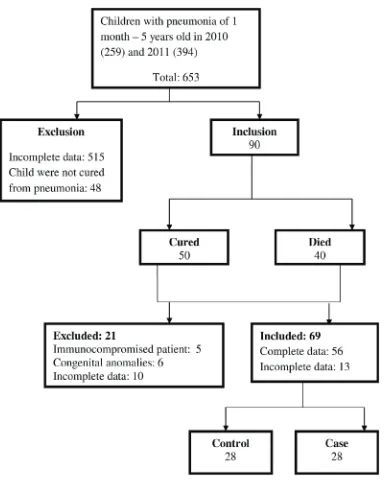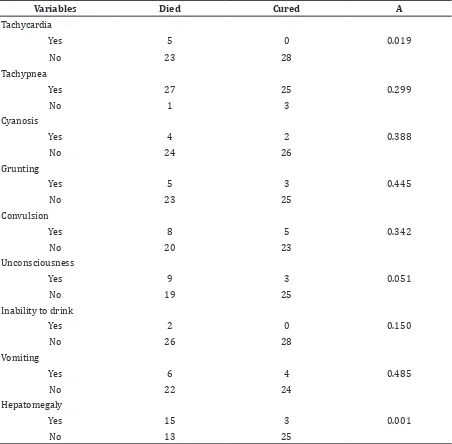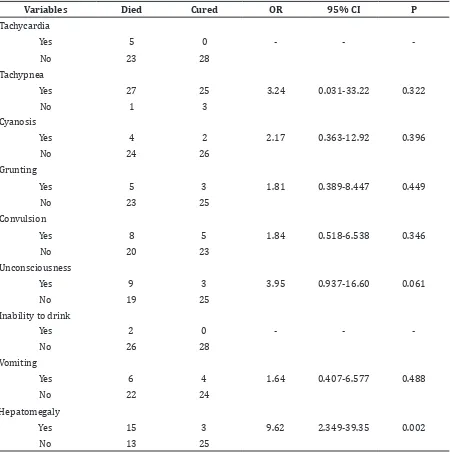Clinical Profile and Mortality in Children with Pneumonia
Ashvinii Manivel,1 Sri Sudarwati,2 RB. Soeherman Herdiningrat3
1Faculty of Medicine Universitas Padjadjaran, 2Department of Child Health Faculty of Medicine,
Universitas Padjadjaran/Dr. Hasan Sadikin General Hospital, Bandung, 3Department of Anatomy and Cell Biology, Faculty of Medicine Universitas Padjadjaran
Abstract
Background : Pneumonia is the leading killer in under-five children. Therefore, by identifying the danger signs, we are able to predict children who are at higher risk of mortality. The objective of the study is to identify the relationship between the clinical profile and mortality in children with pneumonia at Dr. Hasan
Sadikin General Hospital, Bandung.
Methods: This was an analytical study with a retrospective case control approach using medical records with patient’s age limitation of 1–60 month. The study period started on January 1st 2010 and ended on December 31st 2011. All types of pneumonia included whereas congenital anomalies, immunocompromised and Down’s syndrome patients were excluded in this study. Data were presented as frequency distribution. Results : During the study period, there were 653 children under age of 5 with pneumonia. Only 56 subjects met the inclusion and exclusion criteria. Twenty-eight patients with pneumonia were cured and 28 died. Based on the phi’s coefficient, tachycardia (α-value = 0.019) and hepatomegaly (α-value = 0.001) were significant predictors of death and based on the Mantel-Haenszel analysis, hepatomegaly (OR=9.62, CI 95% 2.349–39.35) was significant as a risk for mortality. Inability to drink, cyanosis, tachypnea, grunting,
vomiting, convulsion, and unconsciousness were not related to mortality.
Conclusion: Tachycardia and hepatomegaly have a significant relationship with mortality in under-five
children with pneumonia. [AMJ.2015;2(1):235–40]
Keywords: Children, clinical sign, death, pneumonia, predictor
Correspondence: Ashvinii Manivel, Faculty of Medicine, Universitas Padjadjaran, Jalan Raya Bandung-Sumedang Km.21, Jatinangor, Sumedang, Indonesia, Phone: +6287726091120 Email: ashviniimanivel@hotmail.com
Introduction
Pneumonia has been the leading killer in under-five children where it kills more than
5 million children worldwide.1 It is the major cause of child mortality specially in developing countries.2 Indonesia is one of the 15 countries
that is responsible for three quarters of childhood pneumonia cases globally in under-five children.1
A National Household Health Survey held
in 2001 in Indonesia showed that pneumonia
causes death of in nearly 300 infants every day.3
In spite of the administration of antibiotics, the
prevalence of pneumonia is high and still kills
more children than AIDS, Measles and Malaria
combined.1
WHO has implemented Acute Respiratory Infection (ARI) control program to screen
children with higher risk of death. However,
this program used lower chest wall findings as
signs for predicting death, causing over referral of suspected pneumonia to the hospital.2,4
Several studies showed tachypnea and anemia are predictors of death in pneumonic
children, but it is understood that further
research needed to determine their
significance.2 It is also shown that inability to
drink and cyanosis have been considered as
danger signs for urgent referral and according
to WHO, inability to drink and cyanosis has proven to be danger signs for very severe
pneumonic patient.1 Many studies have shown various clinical signs that predict death in pneumonia.2,3,5-8 However, less number of
studies are carried out in Indonesia.
The objective of the study is to identify the relationship between the clinical profile and
mortality among children with pneumonia in Dr. Hasan Sadikin General Hospital, Bandung,
Indonesia.
Methods
under-236 AMJ June, 2015
Figure 1 Flow chart on Children of 1 month – 5 years old with Pneumonia in 2010 and 2011 in Department of Child Health of Dr. Hasan Sadikin General
Hospital Bandung.
five children with any type of pneumonia
admitted in Department of Child Health of Dr.
Hasan Sadikin General Hospital from January 1st 2010–December 31st 2011 were eligible
for this study.
Patients with congenital anomalies, immunocompromised and Down’s syndrome and incomplete data in the medical record
were excluded. Nine danger signs, i.e. tachycardia, tachypnea, cyanosis, grunting,
convulsion, unconsciousness, inability to
drink, vomiting, and hepatomegaly, were assessed to determine their relationship with death in children under-5 with pneumonia.
Table 1 Cross Tabulation of Clinical Signs with Mortality using Phi’s Coefficient
Variables Died Cured Α
Tachycardia
Yes 5 0 0.019
No 23 28
Tachypnea
Yes 27 25 0.299
No 1 3
Cyanosis
Yes 4 2 0.388
No 24 26
Grunting
Yes 5 3 0.445
No 23 25
Convulsion
Yes 8 5 0.342
No 20 23
Unconsciousness
Yes 9 3 0.051
No 19 25
Inability to drink
Yes 2 0 0.150
No 26 28
Vomiting
Yes 6 4 0.485
No 22 24
Hepatomegaly
Yes 15 3 0.001
No 13 25
five children with any type of pneumonia
admitted in Department of Child Health of Dr.
Hasan Sadikin General Hospital from January 1st 2010–December 31st 2011 were eligible
for this study.
Patients with congenital anomalies, immunocompromised and Down’s syndrome and incomplete data in the medical record were excluded. Nine danger signs, i.e. tachycardia, tachypnea, cyanosis, grunting,
convulsion, unconsciousness, inability to
drink, vomiting, and hepatomegaly, were assessed to determine their relationship with death in children under-5 with pneumonia.
The sample size of the study was calculated by using tachycardia as a significant mortality
predictor with OR 6.075.3 The level of
significance was 0.05% and power of 80%.
Both case and control group showed the same
ratio. Total minimum sample size required for validity is 48; 24 children per group needed.9
Univariate analysis was done to know the
distribution and percentage of age and sex of patient. Cross tabulation using phi’s coefficient was used to assess the relationship between the clinical profile and mortality. The level of significance was alpha <5%.
238 AMJ June, 2015
the odd ratio to analyze the odds of death
occurring in children with pneumonia
Results
In 2010, 7.7% of pneumonia patients died, while in 2011, 5.5% patients died. In table 1, data showed that tachycardia and hepatomegaly had significant relationship with
death in children under 5 with pneumonia.
In table 2, odd ratio was analyzed. Hepatomegaly (OR 9.62; p= 0.02) correlated significantly with death in pneumonia patients.
Discussion
The mortality rates in the Department of Child
Health of Dr. Hasan Sadikin Hospital, Bandung
in year 2010 was 7.7% and in 2011 was 5.1%. In the cross tabulation test, tachycardia and hepatomegaly were found as a significant
predictor of death in pneumonia children. However, a study in Papua New Guinea
showed no correlation between the 2 factors
with mortality.5
Occurrence of tachycardia can be explained
Table 2 Bivariate Analysis of Clinical Signs Association with Mortality using Odd Ratio
Variables Died Cured OR 95% CI P
Tachycardia
Yes 5 0 - -
-No 23 28
Tachypnea
Yes 27 25 3.24 0.031-33.22 0.322
No 1 3
Cyanosis
Yes 4 2 2.17 0.363-12.92 0.396
No 24 26
Grunting
Yes 5 3 1.81 0.389-8.447 0.449
No 23 25
Convulsion
Yes 8 5 1.84 0.518-6.538 0.346
No 20 23
Unconsciousness
Yes 9 3 3.95 0.937-16.60 0.061
No 19 25
Inability to drink
Yes 2 0 - -
-No 26 28
Vomiting
Yes 6 4 1.64 0.407-6.577 0.488
No 22 24
Hepatomegaly
Yes 15 3 9.62 2.349-39.35 0.002
by the inflammatory reaction that interferes with the gaseous exchange in lung. The disturbances of gaseous exchange increases
the alveolar and arterial PO2 differences, thus leads to tachypnea and tachycardia as a compensation mechanism.10
A study conducted in Thailand also showed
that hepatomegaly has association to death.12
Several mechanisms had been proposed to explain the presence of liver enlargement. It
is suggested that congestion of liver with red
blood cells in pneumonia patients with anemia or chronic liver disease could be a reason for
enlarged liver.11,13 Hyperinflation of lung could
causes liver edge to be pushed further below and is palpable in the physical examination.
Although in this study other clinical signs showed no relationship, danger signs such
as inability to drink and cyanosis were found to be important death predictors.5,14 When
patients reach exhaustion, they experience a ventilation and perfusion mismatch, leading
to a hypoxia state and probably respiratory
failure.15
Patients in Dr. Hasan Sadikin General Hospital received immediate interventions
of ventilator and oxygen, so this could be
a reason why cyanosis was not found in
the subject. However inability to drink and grunting were mostly absent due to failure
of physician in recording these signs during physical examination and history taking.
Convulsion and unconsciousness were
not associated with death but associated with encephalopathy. In pneumonia, acute hypoxia can be the causative factor for hypoxic ischemic encephalopathy. This lack of oxygen to the brain will decrease the level
of consciousness and causes convulsions to occur.16Some patient experience vomiting
which was probably due to bacterial causative
pneumonia.17
The limitations of the study was the availability of data in the medical records. During the observation of the medical record,
it was found that most of the physicians fail to note the important danger pneumonia signs in anamnesis and physical examination. A
standardized medical record for pneumonia should be established by which physician must
meet during the management of pneumonia patients.
Besides, most of the patients were sent
home against advice. The mortality statuses
of these patients were not known, thus
limiting the number of data analyzed as
patients underwent complete management
of pneumonia. This study concludes that
tachycardia and hepatomegaly is a significant
mortality predictors in children under 5 with pneumonia at Dr. Hasan Sadikin Hospital, Bandung.
References
1. Wardlaw T, Johansson EW, Hodge M.
Pneumonia: The forgotten killer of children. New York: The United Nations Children’s Fund / World Health Organization; 2006 [Cited 2012 March 16]; Available from: http://www.unicef.org/.
2. Lupisan S, Ruutu P, Erma Abucejo-Ladesma
P, Quiambao BP, Gazom L, Sombrero L,
et al. Predictors of death from severe
pneumonia among children 2–59 months old hospitalized in Bohol, Philipines : implications for referral criteria for at first-level health facility. Trop Med Int Health. 2007;12(8):962–71.
3. Kisworini P, Setyati A, Sutaryo. Mortality predictors of pneumonia in children.
Paediatr Indones. 2010;50(3):149–53.
4. Mulholland K. Childhood pneumonia
mortality: a permanent global emergency. Lancet. 2007;370(9583):285–9.
5. Shann F, Barker J, Poore P. Clinical signs that predict death in children with
severe pneumonia. Pediatr Infect Dis J. 1989;8(12):852–5.
6. Deivanayagam N, Nedunchelian K,
Ramasamy S, Sudhandirakannan, Ratnam S. Risk factor for fatal pneumonia : a case control study. Indian Pediatr. 1992;29(12):1529–32.
7. Narayanan M, Falade A. Clinical risk factors for death in children with pneumonia.
Australia: International Child Health Review Collaboration; 2006 [Cited 2012 March 23]; Available from: http://www.
ichrc.org.
8. Sehgal V, Sethi GR, Sachdev HP,
Satyanarayana L. Predictors of mortality
in subjects hospitalized with acute lower respiratory tract infections. Indian Pediatr. 1997;34(3):213–9.
9. Sainani K. Sample size for case control. Stanford: 2007 [Cited 2012 June 12]; Available from: http://www.stanford.edu.
10. Crowe JE. Kendig’s disorders of the
respiratory tract in children. 7th ed. Victor C, Boat TF, editors. Philadelphia: W.B.
Saunders Company; 2006.
11. Lakhanpaul M, Atkinson M, Stephenson
240 AMJ June, 2015
12. Suwanjutha S, Ruangkanchanasetr S,
Chantarojanasiri T, Hotrakitya S. Risk factors associated with morbidity and mortality of pneumonia in Thai children under 5 years. Southeast Asian J Trop Med Public Health. 1994;25(1):60–6.
13. Wintrobe M, Greer J. Wintrobe’s Clinical
Hematology. 12th ed. Greer JP, editor. Philadelphia: Wolters Kluwer Health/ Lippincott Williams & Wilkins; 2009. 14. Nascimento-Carvalho C, Rocha H, Jesus
RS, Benguigui Y. Childhood Pneumonia:
Clinical Aspects Associated with
Hospitalization or Death. Braz J Infect Dis. 2002;6(1):22–8.
15. Mbugua S. Pneumonia in Pre-School
Children. Turku: Turku University of
Applied Sciences; 2011.
16. David R. Clinical Pediatric Neurology.
3rd ed. David R, editor. New York: Demos Medical Publishing; 2009.


